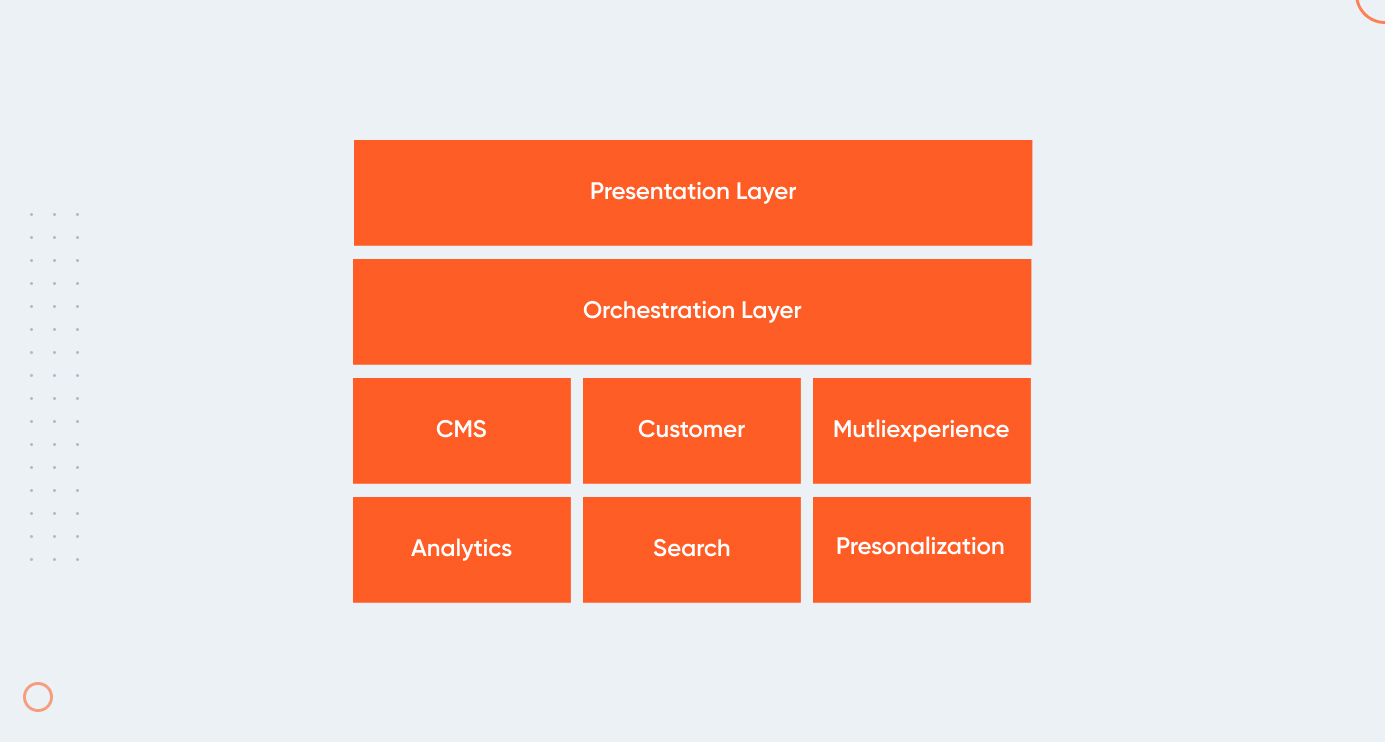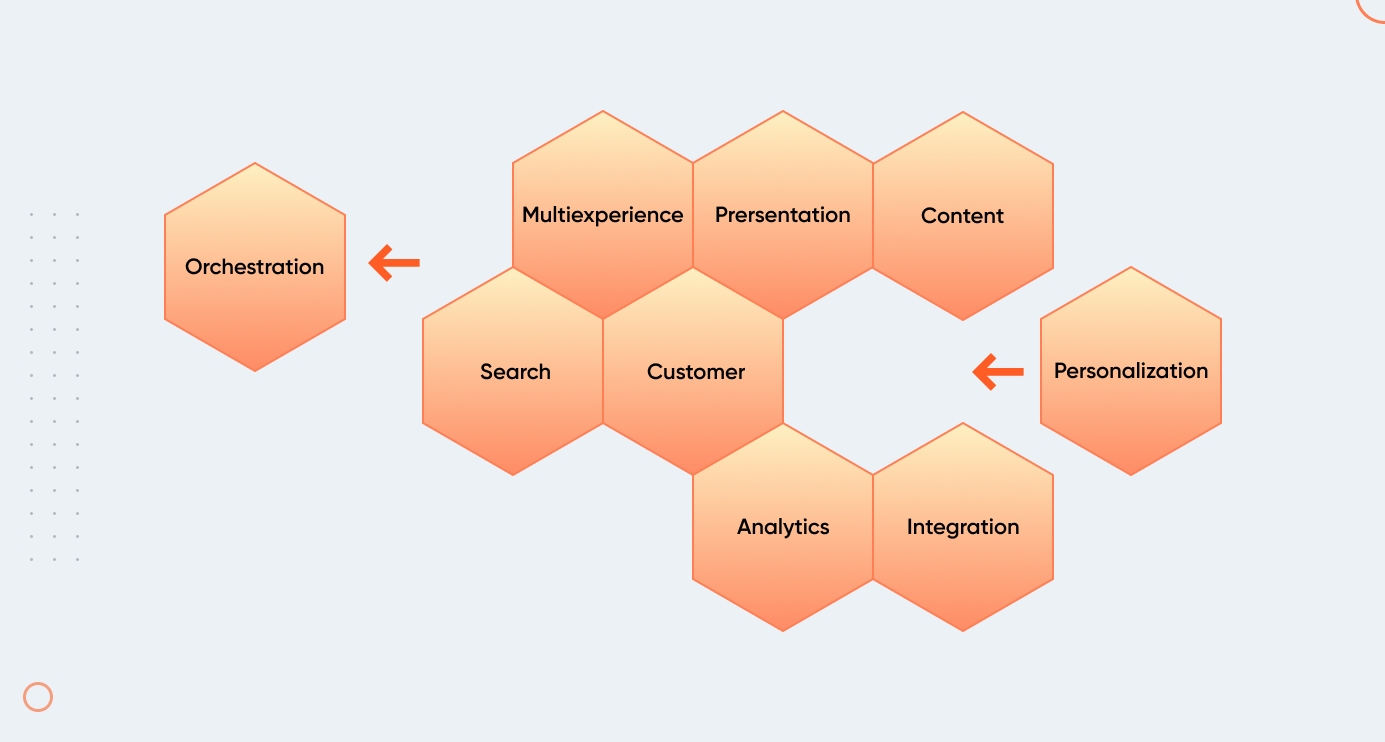Introduction
By 2023, organizations with a monolithic DXP will be outpaced by competition using composable by eighty percent in implementing new features on their platform according to a gated 2019 report by Gartner.
The necessity of integrating new platform functionalities, faster, will continue to increase with growing customer expectations.
Before moving to composable, you need answers to key questions:
- What is monolithic and how is it different from composable?
- Which challenges would a composable DXP solve?
- How do I go about implementing a composable DXP?
Your search for answers to these questions ends here.
What Is A Monolithic DXP?
A monolithic DXP is somewhat similar to a traditional CMS, in which the front-end and backend layers are coupled. This system is made for powering a single digital channel like a mobile application or a website.
Most small and medium-sized businesses usually rely on monolithic DXPs as it was part of their existing tech stack, and they never bothered to swipe it out for a modern solution. Your organization might also fall within this bracket with the majority.
The main problem with monolithic stackos is that they create friction when implementing changes. This friction can exist because of the time it takes to implement every little change, cost requirements, and the resources required by the developers and QA teams to understand the entire stack. Testing also becomes harder to perform in monolithic stacks.
What Is A Composable DXP?
A composable DXP, on the other hand, is a digital experience platform that can bridge the gap between the digital experiences of different datasets in an organization like the customer, users, and employees. It removes the challenges posed by monolithic DXP and takes the customer experience to the next level.
Composable DXP gives you the freedom to connect multiple channels by using APIs. APIs can also be leveraged to connect new digital touchpoints vital for your business. DXP further brings content and data together seamlessly to provide a personalized experience to customers. Given these features, a composable DXP will work as the backbone of all your digital content and efforts if implemented correctly.
You will have the control to tailor it around your existing processes and infrastructure. Further, APIs and DXP integrations, as the building blocks, will allow you to deliver a high-quality digital experience to your customers as quickly as they need it. Other than understanding what is a composable DXP, you should also follow the DXP discovery process to figure out your DXP requirements.
Monolithic Limitations & Composable Solutions
You now know that monolithic DXPs come with a lot of limitations. And these limitations will only become more glaring with time as the number of digital channels and touchpoints for customer interactions grows.
With this, it’s important to listen to what your consumers say. According to a 2020 Deloitte study on customer behavior, 75% of consumers want consistent interactions across all departments. This is relevant because customers are accessing multiple touchpoints before making a purchase. Businesses need to remember that the digital experience that your brand creates can’t afford to miss the mark.
A monolithic DXP will not help you with this due to its many challenges. Thankfully, composable DXPs provide the right solution to most of those challenges.
|
Monolithic DXP Limitations |
Composable DXP Solutions |
|
Omnichannel Possibilities 🔗 |
|
|
Starting Short: The primary problem with a monolithic DXP is that you are already starting short by opting for it in today’s digital environment. Because:
With a monolithic DXP, it will be quite difficult to keep up with these changes. |
Use of APIs: A composable DXP uses APIs to:
This allows you to meet the basic demand and excel by launching consistent campaigns that support digital experience on all platforms. |
|
Improving Customer Experiences 👍 |
|
|
Limited Capability: More often than not, Monolithic systems make it challenging to:
While the customer expects you to be swift and provide better experiences in real-time monolithic systems, if not designed well can limit businesses to take timely actions. |
Relevant Analytics & Reports: With composable DXPs, you can integrate analytics and reports relevant to your business with ease. This helps in:
Businesses that personalize their customer experience are able to grow. It is important to ask if your business falls in this category. |
|
Ease of Development 👨💻 |
|
|
Baked-In Rigidity: Monolithic DXPs tend to be a pain for modern developers to handle. This is because:
At the end of the day, this hinders the developers and pace of the project. |
Face Changes Head-On: You don’t have to be afraid of changes if you have a composable DXP to rely on. With composable DXP your business can:
With innovation happening at the speed of light, this allows your organization to always stay ahead of the competition. |
|
Scalability📈 |
|
|
Overloading: Businesses are always trying to grow bigger. Sadly, things might get overloaded as you add more:
With monolithic DXP, you will be left struggling to keep up with these changes. |
Ease of Scalability: A composable DXP allows you to respond to changes quickly. This will allow you to:
All of this can happen whenever there is a market opportunity. |
|
Building The New 🛠 |
|
|
Re-Platforming: Let’s consider that there will be a new customer channel tomorrow.
In all of these scenarios, you will have to re-platform if you have a monolithic DXP. |
Flexibility: With a composable DXP, you will be able to select the best tool for the job and your business. This means:
Ensure that your customers don’t choose your competitors over you simply because you lack the flexibility to respond to their needs. |
Omnichannel Possibilities
Monolithic DXP Limitations
Starting Short:
The primary problem with a monolithic DXP is that you are already starting short by opting for it in today’s digital environment. Because:
- The number of channels for publishing will continue to grow
- Software tools that make up your tech stack will increase in number
With a monolithic DXP, it will be quite difficult to keep up with these changes.
Composable DXP Solutions
Use of APIs:
A composable DXP uses APIs to:
- Enable you to connect to multiple channels
- This gives you the control to create an omnichannel digital experience
- The experience is customized throughout the customer journey
This allows you to meet the basic demand and excel by launching consistent campaigns that support digital experience on all platforms.
Improving Customer Experiences
Monolithic DXP Limitations
Limited Capability:
More often than not, Monolithic systems make it challenging to:
- collect data points from all channels.
- Adopting and integrating with modern reporting and analytics
- Integrating marketing automation tools
While the customer expects you to be swift and provide better experiences in real-time monolithic systems, if not designed well can limit businesses to take timely actions.
Composable DXP Solutions
Relevant Analytics & Reports:
With composable DXPs, you can integrate analytics and reports relevant to your business with ease. This helps in:
- Gather better insights into how your customers navigate
- Collect insight into the digital experiences of your customers
- Help you adapt to any required changes
- Provide personalized experience
Businesses that personalize their customer experience are able to grow. It is important to ask if your business falls in this category.
Ease of Development
Monolithic DXP Limitations
Baked-In Rigidity:
Monolithic DXPs tend to be a pain for modern developers to handle. This is because:
- New frontend frameworks and tools continue to emerge every year
- Monolithic DXP lack the flexibility to allow the selection of frameworks and tools suited for any task
- Monolithic DXPs have rigid templates that restrict developers from adopting a different and creative approach
At the end of the day, this hinders the developers and pace of the project.
Composable DXP Solutions
Face Changes Head-On:
You don’t have to be afraid of changes if you have a composable DXP to rely on. With composable DXP your business can:
- Connect to new digital touchpoints and channels by leveraging APIs
- Build and personalize web experiences
- Test multiple variants of your marketing campaigns
- Get detailed insights and see tangible results
With innovation happening at the speed of light, this allows your organization to always stay ahead of the competition.
Scalability
Monolithic DXP Limitations
Overloading:
Businesses are always trying to grow bigger. Sadly, things might get overloaded as you add more:
- Software applications
- Websites
- Editors
With monolithic DXP, you will be left struggling to keep up with these changes.
Composable DXP Solutions
Ease of Scalability:
A composable DXP allows you to respond to changes quickly. This will allow you to:
- Be faster to implement changes
- Roll out new campaigns
- Adopt modern technologies
All of this can happen whenever there is a market opportunity.
Building The New
Monolithic DXP Limitations
Re-Platforming:
Let’s consider that there will be a new customer channel tomorrow.
- How will you deal with that?
- What if a better analytics tool is launched to give you insight into how your customers convert across campaigns?
- What if a more streamlined social media or marketing automation tool is launched?
In all of these scenarios, you will have to re-platform if you have a monolithic DXP.
Composable DXP Solutions
Flexibility:
With a composable DXP, you will be able to select the best tool for the job and your business. This means:
- You always have the flexibility to integrate tools to your existing stack that best suit your business
- You evolve with the changing expectations of your customers
Ensure that your customers don’t choose your competitors over you simply because you lack the flexibility to respond to their needs.
Helpful Considerations When Decomposing & Replacing The DXP Monolith
Start by answering the question: Do I Need A DXP? If you do, figure out a roadmap for moving from a monolithic to a composable structure. This becomes challenging with the realization that there is no “one” roadmap from a monolithic to a composable DXP.
Moving to composable isn’t so much a journey as it is a process of reconstruction. You have to break down the older system, over time, while simultaneously integrating pieces of what will become the new.
This reconstruction can only be successful if decision makers are focused on ensuring that the right people are involved, that your processes evolve, and that the right technologies are used.
1. People: Consult SMEs For Specific Components
Take advantage of digital product management that enables continuous delivery of exceptional services and innovation. Assess the ability of your business to meet your customers' rapid and increasing demand for integrated, personalized, and frictionless digital experiences.
The key point that you need to remember is that you don’t need everybody to know everything. Instead, you can have experts for different components. From having business stakeholders that are open to adopting modern technology to having the right blend of frontend developers, backend developers, quality analysts, and subject matter experts, everything is essential.
But what if you lack the right blend of people in your team? In that case, we at Axelerant can help you out. Book a consultation with us to know how we can help you reach higher digital maturity today!
2. Process: Go From Singular To Multi-experience Delivery
The second step is adoption of multi-experience product delivery. Here, a shift in mentality from channel focused traditional model to one that encompasses the entire customer journey and delivers a seamless customer experience over various channels and platforms is required. The goal for this step should be to make the content more structured and granular for composable content delivery.
3. User Experience: Achieve A Unified, Composable UX Layer
The three core components of a DXP are content management, personalization, and presentation. The movement towards modular DXPs that enable application composability is quite suited as the first step in your journey towards the future of a composable business.
The next step will involve enabling the composable UX in the evolution of DXP. Here, interfaces and experiences can be assembled by non-technical business users based on the end-user persona and their roles.
In this manner, evolved DXPs will have a special horizontal role that comprises experiences from multiple PBCs (Packaged Business Capabilities). It will also provide an Application Composition Platform (ACO), where the DXP will package the PBCs and provide a unified composable UX layer.
4. Tech: Customizing As Per Requirement
Tech plays an integral role in journeying from monolithic to composable DXP. There are several options available for organizations to choose from, including Drupal, Acquia, Salesforce, and Wordpress for their CMS, Acquia for CDP, and low-code/no-code site building can be done through Site Studio of Acquia, Gutenberg of Wordpress, and Layout Builder of Drupal.
When & How To Begin?
When do you need to start making your digital experience platform composable? The short answer: the sooner the better.
The long answer: evaluate where your platform is now and where it needs to be in a few years. As technology changes rapidly, businesses that don’t prepare will be left behind.
How to begin? Nobody makes big digital change alone. There are many technical implementation partners that can help your organization move from monolithic to composable—and Axelerant is one of them.
Composable DXP Implementation Example
Our technical teams implemented a composable DXP solution while consolidating digital experiences for 90+ brands for a retail megalith. The project was challenging—out of nearly 90 brands, some were on Drupal and others were on a mix of Open Source and proprietary CMSs. Not all had a web presence, and most brands only had physical stores. The ones with a web presence were missing eCommerce capabilities.
To speak with those who helped make this migration successful, schedule a call.

Prateek Jain, Director, Digital Experience Services
Offline, if he's not spending time with his daughter he's either on the field playing cricket or in a chair with a good book.

Akanksha Singh, Senior Drupal Engineer
Voracious bibliophile. When she's not working, she reads; when she's not reading, she works. 100+ books annually, eight-plus monthly, two weekly—cover to cover, no excuses.

Simran Sethi, Content Marketer
Simran is an avid reader. She is an active runner, who also likes to swim, dance, and sing. For her, the meaning of life lies in the little things. Kindness, passion, and compassion are her life’s essential values.

 We respect your privacy. Your information is safe.
We respect your privacy. Your information is safe.



Leave us a comment